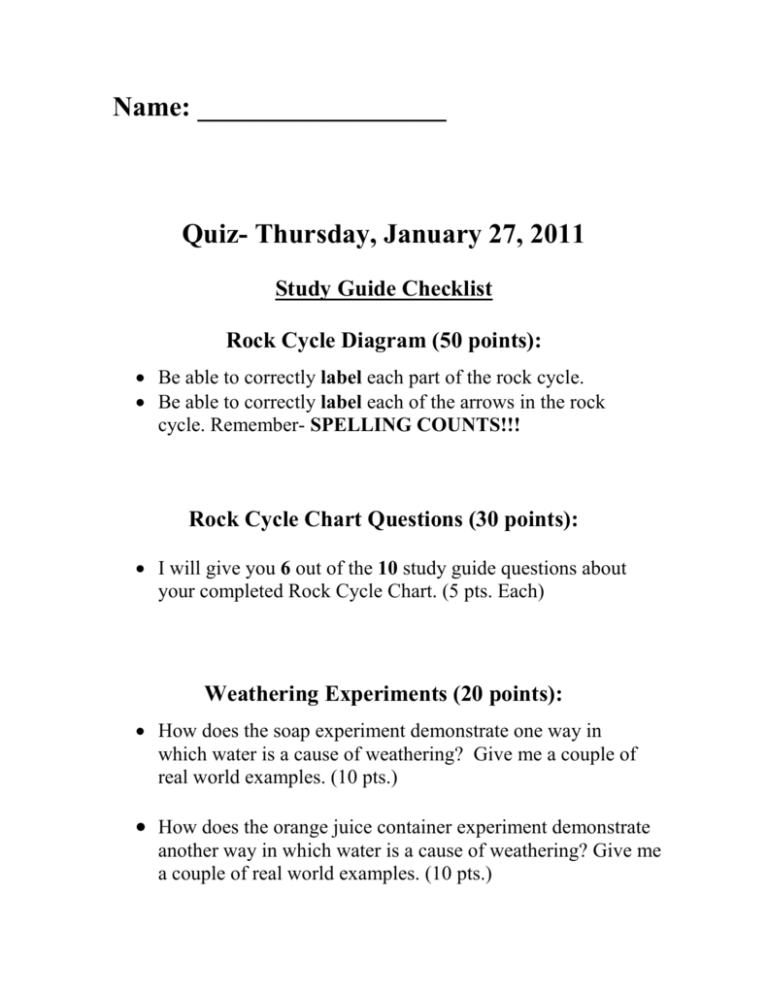Quiz- Thursday, January 27, 2011
advertisement

Name: __________________ Quiz- Thursday, January 27, 2011 Study Guide Checklist Rock Cycle Diagram (50 points): Be able to correctly label each part of the rock cycle. Be able to correctly label each of the arrows in the rock cycle. Remember- SPELLING COUNTS!!! Rock Cycle Chart Questions (30 points): I will give you 6 out of the 10 study guide questions about your completed Rock Cycle Chart. (5 pts. Each) Weathering Experiments (20 points): How does the soap experiment demonstrate one way in which water is a cause of weathering? Give me a couple of real world examples. (10 pts.) How does the orange juice container experiment demonstrate another way in which water is a cause of weathering? Give me a couple of real world examples. (10 pts.) Rock Cycle Diagram: Fill in the rock cycle diagram below. Be sure to correctly label all arrows! When you are finished, go to the last page of the study guide to check your work! Rock Cycle Chart Questions: Use your completed diagram to answer the following questions. When you are finished, go to the last page of the study guide to check your work. 1) What are the 3 types of rocks? 2) How does magma form igneous rock? 3) What breaks down igneous rocks into sediments? 4) How can metamorphic rocks be changed into sedimentary rocks? 5) What changes sedimentary rock to metamorphic rock? 6) What happens when the minerals in igneous, sedimentary, and metamorphic rocks completely melt? 7) How can igneous rocks turn into metamorphic rocks? 8) What are the 2 things that happen when sediments form into a sedimentary rock? 9) What is the only rock that can form directly from magma? 10) What kinds of rocks can be changed to form metamorphic rocks? Weathering Experiments: 1) How does the soap experiment demonstrate one way in which water is a cause of weathering? Give me a couple of real world examples. 2) How does the orange juice container experiment demonstrate another way in which water is a cause of weathering? Give me a couple of real world examples. Rock Cycle Study Guide Answer Key: The Rock Cycle Cooling & Hardening Igneous Rock Weathering & Erosion Magma Heat & Pressure Sediments Melting Weathering & Erosion Metamorphic Rock Heat and Pressure Compaction and Cementation Sedimentary Rock Rock Cycle Chart Questions: 1) What are the 3 types of rocks? The 3 types of rocks are igneous rocks, sedimentary rocks, & metamorphic rocks. 2) How does magma form igneous rock? Magma forms into igneous rock by cooling & hardening. 3) What breaks down igneous rocks into sediments? Weathering & erosion break down igneous rocks into sediments. 4) How can metamorphic rocks be changed into sedimentary rocks? Two things need to happen: 1) Metamorphic rocks first need to be broken down into sediments by weathering & erosion. 2) Those sediments then need to be compacted & cemented together to form a sedimentary rock. 5) What changes sedimentary rock to metamorphic rock? Heat & pressure change sedimentary rocks into metamorphic rocks. 6) What happens when the minerals in igneous, sedimentary, and metamorphic rocks completely melt? When the minerals in rocks completely melt, they turn into magma. 7) How can igneous rocks turn into metamorphic rocks? Igneous rocks turn into metamorphic rocks by heat & pressure. 8) What are the 2 things that happen when sediments form into a sedimentary rock? When sediments get compacted & cemented together, they form sedimentary rocks. 9) What is the only rock that can form directly from magma? The only rocks that can form directly from magma are igneous rocks. 10) What kinds of rocks can be changed to form metamorphic rocks? Both igneous & sedimentary rocks can change into metamorphic rocks. Weathering Experiments: 1) How does the soap experiment demonstrate one way in which water is a cause of weathering? Give me a couple of real world examples. o There are many examples where moving water wears down the surface of rocks like it did in our soap experiment: Drainage of rainwater in the same place over time. The constant movement of rivers & streams. Water that drips in the same spot over time. 2) How does the orange juice container experiment demonstrate another way in which water is a cause of weathering? Give me a couple of real world examples. Water gets in the cracks of rocks. (Seeping) The water then freezes. The water expands when it freezes. The expanding of ice pushes the rock apart even more. Over time, this constant seeping & freezing of water will cause the rock to break apart. o This whole process is called Ice Wedging: o o o o o o THE ORANGE JUICE EXPERIMENT IS A GREAT EXAMPLE OF ICE WEDGING! Examples that show the damage caused by ice wedging: Rocks that have been split apart by ice wedging. Roads that have been broken apart by ice wedging.






